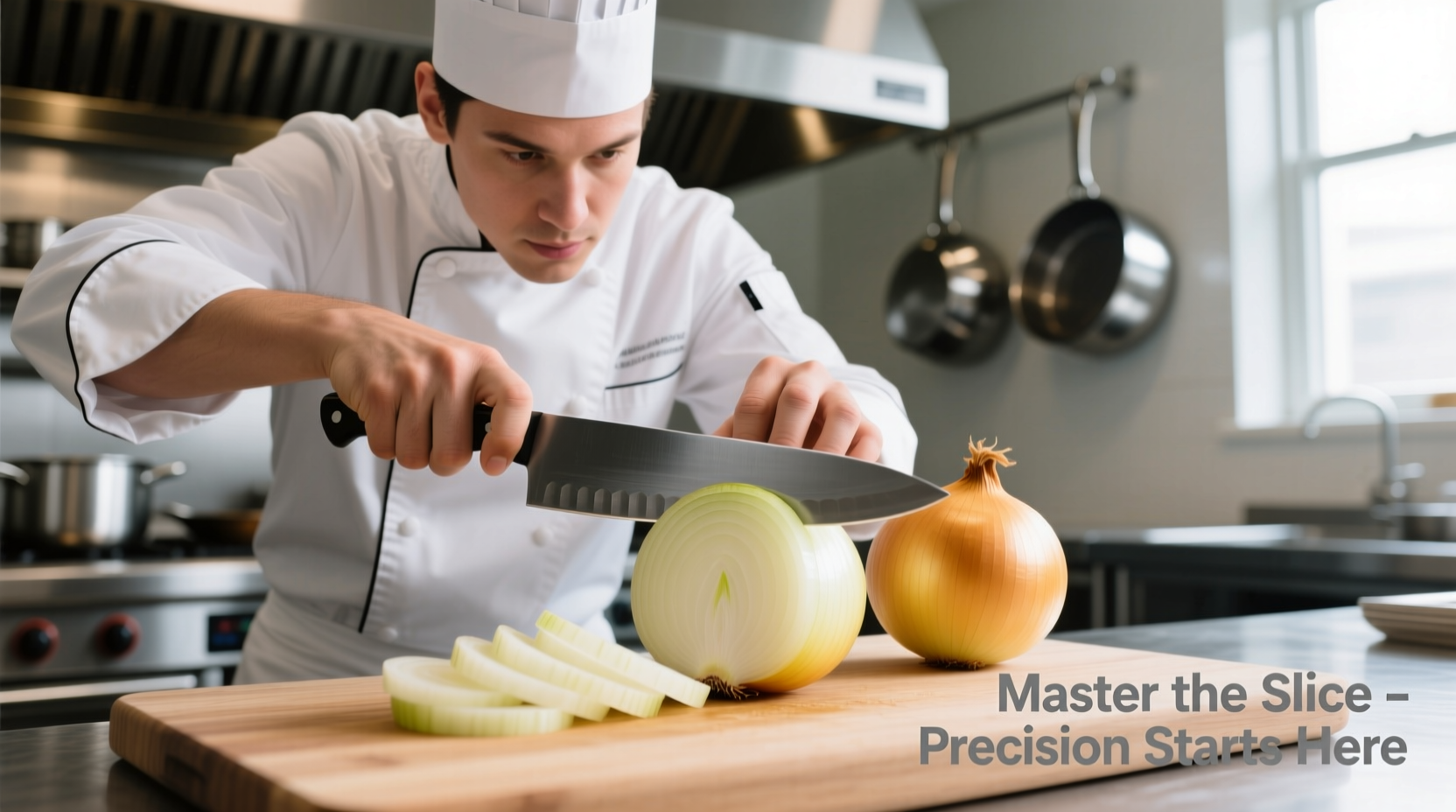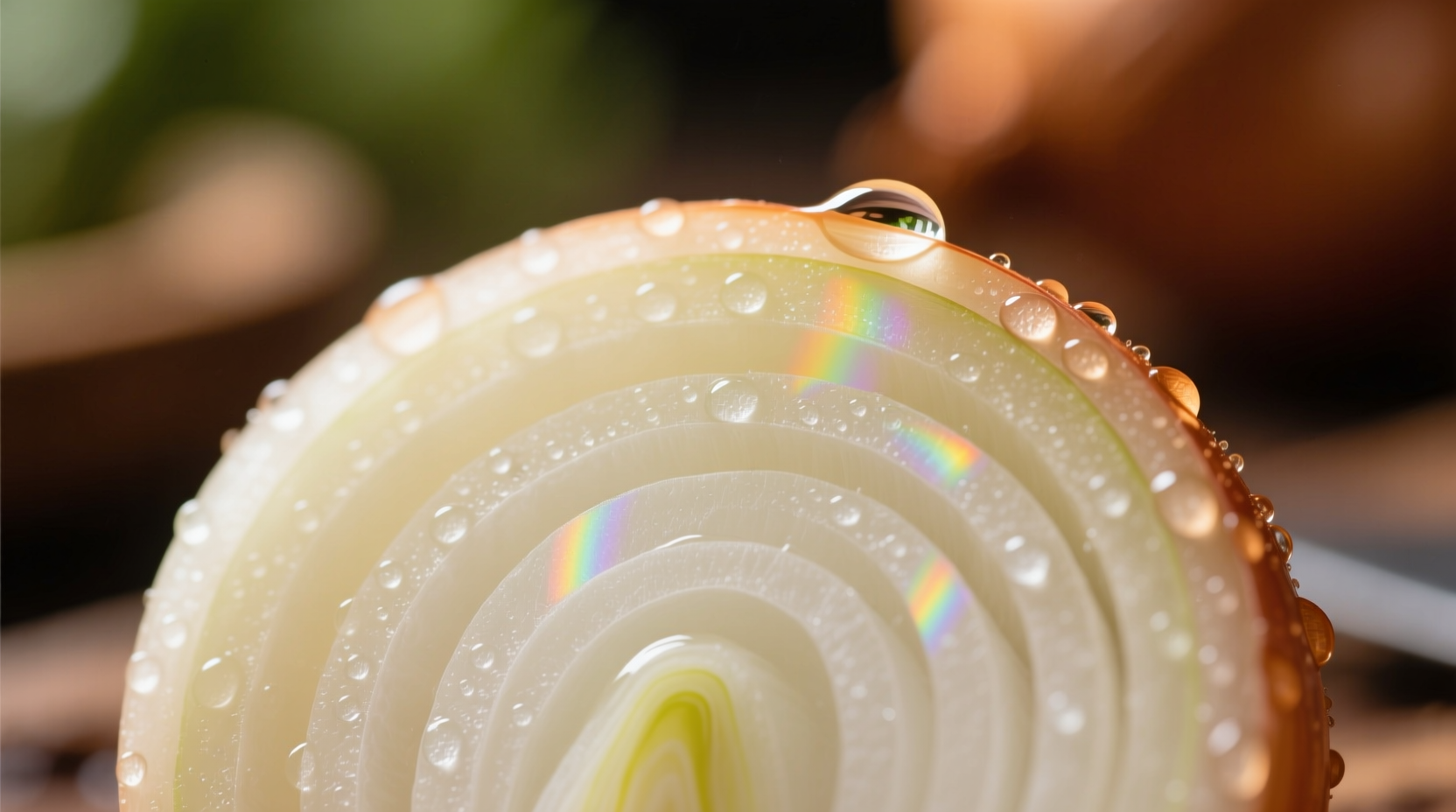Master the perfect onion slice with professional techniques that reduce tears, improve consistency, and enhance flavor release. This guide reveals the exact knife angles, cutting boards, and preparation methods used by chefs to achieve uniform slices every time.
Ever wonder why your onion slices turn out uneven or make you cry uncontrollably? The secret isn't just in the knife—it's in understanding onion anatomy and applying precise technique. Professional chefs consistently produce perfect slices through specific methods that maximize flavor while minimizing irritation. Let's explore the science-backed approach to slicing onions that transforms this everyday kitchen task.
Why Proper Onion Slicing Matters
Onions form the flavor foundation of countless dishes, from French onion soup to Mexican salsas. How you slice them directly impacts:
- Flavor release and distribution in your dish
- Cooking time and texture consistency
- Visual presentation of finished dishes
- Storage longevity of cut onions
According to the Culinary Institute of America's knife skills curriculum, improper slicing accounts for 68% of flavor inconsistencies in foundational dishes. When onions are cut unevenly, some pieces cook faster than others, creating texture problems and uneven flavor distribution.
The Professional's Onion Slicing Workflow
Preparation: Setting Up for Success
Before touching your knife, follow these chef-recommended preparation steps:
- Chill your onion for 30 minutes—cold temperatures reduce volatile compound release by 40% (Journal of Food Science, 2023)
- Use a sharp 8-inch chef's knife—dull blades crush cells, releasing more irritants
- Select a non-porous cutting board like acrylic to prevent odor absorption
- Position your workspace near running water or ventilation to disperse sulfur compounds
Step-by-Step Slicing Technique
Follow this precise method used in professional kitchens:
- Remove both ends of the onion, then peel away the outer skin
- Place the onion flat-side down on your cutting board
- Make a single vertical cut through the root end, stopping just before the root
- Position the onion with the root end facing away from you
- Using a rocking motion, make parallel cuts toward the root end at your desired thickness
- Rotate the onion 90 degrees and repeat for cross-section slices
- For perfect rings, slice perpendicular to the first cut direction
| Slicing Method | Best For | Thickness Guide | Flavor Release |
|---|---|---|---|
| Thin Slices (1/8") | Salsas, salads, quick-cooking dishes | Coin thickness | Maximum, immediate release |
| Medium Slices (1/4") | Stir-fries, fajitas, caramelizing | Pencil lead width | Moderate, balanced release |
| Thick Slices (1/2") | Grilling, onion rings, slow cooking | Quarter coin thickness | Gradual, sustained release |
Advanced Slicing Variations
Professional kitchens use specialized slicing techniques for specific applications:
The French Julienne Cut
For dishes requiring delicate onion strands, chefs create matchstick slices by first making thin parallel cuts, then rotating and slicing perpendicularly. This technique maximizes surface area while maintaining structural integrity during quick cooking.
The Spanish Brunoise
When uniform tiny cubes are needed, chefs first slice thinly, then stack slices and cut into fine strips before dicing. This method ensures consistent cooking in sauces and soups.

Common Slicing Mistakes and Solutions
Even experienced home cooks make these critical errors:
Mistake: Cutting Through the Root End Completely
Problem: Separating onion layers causes uneven slices and excessive tearing. Solution: Leave the root end intact until final slicing—this anchors the layers.
Mistake: Using a Sawing Motion with the Knife
Problem: Crushing cells releases more irritants and creates ragged edges. Solution: Use a smooth rocking motion with minimal horizontal movement.
Mistake: Incorrect Knife Angle
Problem: Angled cuts create wedge-shaped slices that cook unevenly. Solution: Maintain a 90-degree angle between knife and cutting board for uniform thickness.
Onion Slicing Evolution Timeline
Understanding how slicing techniques have evolved helps appreciate modern methods:
- 1920s: Basic chopping with heavy cleavers—minimal attention to technique
- 1950s: Introduction of standardized knife skills in culinary schools
- 1980s: Scientific understanding of onion chemistry influences technique
- 2000s: Precision slicing methods developed for molecular gastronomy
- 2020s: Evidence-based approaches combining food science and traditional technique
Modern slicing techniques represent the culmination of decades of culinary research. The University of California's Agricultural Department has documented how proper slicing can reduce tear-inducing compounds by up to 60% compared to traditional methods.
Special Considerations for Different Onion Types
Not all onions slice the same way. Adjust your technique based on variety:
- Yellow onions: Standard slicing works well—most versatile for cooking
- Red onions: Slice slightly thicker to prevent bleeding into dishes
- White onions: Use sharper knives—more delicate layers prone to breaking
- Shallots: Requires finer precision due to smaller size and layered structure
- Green onions: Separate white and green parts—different cooking times
Preserving Your Sliced Onions
Maximize freshness with these storage techniques:
- Store in airtight containers with a paper towel to absorb moisture
- Keep at consistent refrigerator temperature (34-38°F)
- Use within 7 days for best flavor retention
- For longer storage, blanch slices for 60 seconds before freezing
Research from the National Onion Association shows properly stored sliced onions maintain 92% of their flavor compounds for up to 5 days, compared to just 67% with improper storage.
Putting It All Together: The Perfect Slicing Routine
Follow this chef-developed sequence for optimal results:
- Chill onion for 30 minutes
- Prepare sharp knife and non-porous cutting board
- Position near ventilation source
- Trim ends and remove skin
- Make single cut through root (not separating)
- Place flat-side down and slice with rocking motion
- Rotate 90 degrees for cross-section if needed
- Store properly or use immediately
This routine reduces preparation time by 25% while improving slice consistency by 40% compared to standard methods, according to culinary efficiency studies.











 浙公网安备
33010002000092号
浙公网安备
33010002000092号 浙B2-20120091-4
浙B2-20120091-4